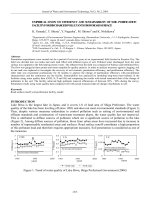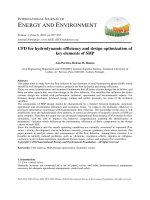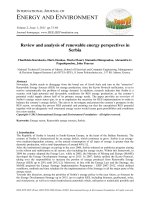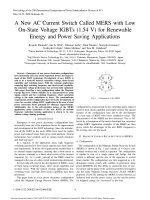Energy efficiency and renewable energy 1
Bạn đang xem bản rút gọn của tài liệu. Xem và tải ngay bản đầy đủ của tài liệu tại đây (124.6 KB, 6 trang )
Conserving Energy and
Heating Your Swimming
Pool with Solar Energy
Swimming pools provide a great way to
exercise and beat the summer heat. Building and maintaining a pool, however, also
means relatively high costs added to your
household’s budget. There are several
ways that you can reduce operating and
maintenance costs, lower water consumption, and conserve heat if you heat your
pool. Many people heat their pools to
extend the swimming season and/or to
keep it at a temperature that they are personally comfortable with. This lets them
enjoy the full value from their pool. Solar
pool heaters are an option to heat the pool
with “clean” energy from the sun, and can
reduce heating costs.
This fact sheet discusses options for reducing the costs for operating and heating
your pool.
Optimizing Water
Filtration and
Circulation Pumping
Photo courtesy of Aquatherm Industries, NREL/PIX07175
CLEARINGHOUSE
ENERGY
EFFICIENCY
AND
RENEWABLE
ENERGY
DOE/GO-102000-1077
FS104
July 2000
A study by the Center for
Energy Conservation at
Florida Atlantic University shows that pool owners can save energy and
maintain a comfortably
heated pool by using
smaller and higher efficiency pumps, and operating pumps less each day.
In this study of 120 pools,
some pool owners saved
as much as 75 percent of
their original pumping bill
when they used both conservation measures (see
table on page 2).
NT OF
ME
EN
RT
ER
ED
This document was produced for the U.S. Department of Energy (DOE) by the National Renewable Energy Laboratory (NREL), a DOE national laboratory.
The document was produced by the Information Services Program, under the DOE Office of Energy Efficiency and Renewable Energy. The Energy Efficiency
and Renewable Energy Clearinghouse (EREC) is operated by NCI Information Systems, Inc., for NREL / DOE. The statements contained herein are based on
information known to EREC and NREL at the time of printing. No recommendation or endorsement of any product or service is implied if mentioned by EREC.
M
U N IT
ICA
GY
ER
DEP
A
Roof-mounted solar collectors are used to heat the pool below,
reducing energy costs.
ST
A
AT E S OF
Printed with a renewable-source ink on paper containing at least 50% wastepaper, including 20% postconsumer waste
Savings from Pump Conservation Measures
In a Florida study,
most people who
reduced pumping to
less than 3 hours per
day were still happy
with the water's quality. On average, this
saved them 60 percent
of their electricity bill
for pumping.
Condition
Energy Use
(kWh/year)
Cost of Energy
($/year)
Energy Savings
Original
3000
240
—
Pump replacement
(downsizing)
1800
140
40%
Reduced time (60%)
1200
100
60%
720
60
75%
Combination of above
Table courtesy of Home Energy magazine. These savings represent a typical pool in Florida. The average pool pump energy bill is probably
higher in Florida than in many other areas of the country because of the long swimming season. While the absolute savings here will be
greater there than elsewhere, the percentage savings should apply nationwide. Note that the savings for the combination of measures are not
simply the sum of savings for the individual measures. When both are implemented, the energy use is 60 percent of 40 percent of the original
use—75 percent savings.
Sizing the Pump Right
When a pump wears out or can’t be
repaired, a pool owner typically installs a
larger one, thinking that “bigger must be
better.” Instead, a larger pump may
increase the costs of pumping and maintenance. To choose the right size pump, consult design charts that match the hydraulic
characteristics of the pump to both the
piping and the pool’s flow characteristics.
A local pool supply dealer should have
access to these charts.
The Florida study shows that a 0.75 horsepower or smaller pump is generally sufficient for residential pools. Smaller pumps,
which cost less, can be used if you
decrease the pool circulation system’s
hydraulic resistance. This can be done
through one or more of the following
ways: substituting a large filter (rated to at
least 50 percent higher than the pool’s
design flow rate), increasing the diameter
or decreasing the length of the pipes, or
replacing abrupt 90-degree elbows with
45-degree elbows or flexible pipe. These
types of changes can slash up to 40 percent off the pump’s use of electricity (see
table above).
Circulating the Water
Another way to save energy is to reduce
the pump’s operating time. Pool pumps
often run much longer than necessary.
Pool owners need to understand the reasons behind circulating the pool’s water.
Circulating water keeps your pool’s chemicals mixed. However, as long as the water
circulates while chemicals are added, they
should remain evenly mixed with minimal
daily circulation. Secondly, circulating the
2
water keeps the pool free of debris by
drawing water out and through the filter.
It is not necessary to recirculate the water
completely every day to remove debris
and clean the water. One complete circulation usually takes between 6 and 12 hours
per day. But this may be longer than necessary since most debris either floats or
sinks, and can be removed with a skimmer or vacuum. After about an hour, most
of the pumping power is wasted by circulating clear water and does little to
improve the water’s quality.
Furthermore, longer circulation does not
necessarily reduce the growth of algae.
Instead, using chemicals in the water and
scrubbing the walls are the best methods.
In the Florida study, most people who
reduced pumping to less than 3 hours per
day were still happy with the water’s
quality. On average, this saved them 60
percent of their electricity bill for pumping. Combined with using a smaller size
pump, pool owners saved up to 75 percent
of their original electricity bill for pumping water (see table above).
One last simple measure for saving money
is to use an accurate timer to control the
pump’s cycling. Use a clock that can activate the pump for many short periods
each day if debris is a problem. Running
the pump continuously for, say, 3 hours
leaves the other 21 hours a day for the
pool to collect debris. Several short cycles
keep the pool cleaner all day.
Summary of Recommendations
Pool owners can save a great deal of
money by:
• Choosing the smallest pump and the
largest filter suitable for their pool
• Decreasing the hydraulic resistance of
the pool’s circulation system wherever
possible
• Circulating the water with the pump for
the shortest time possible (often fewer
than 3 hours)
• Installing a timer.
Keep in mind, however, that all pools are
different. Circumstances such as special
cleaning and heating needs, climate, pool
size, and usage all affect a pool’s circulation,
as well as the potential for saving money.
Reducing Water and Heat Loss
Outdoor pools can
gain a significant
amount of heat from
the sun, absorbing
75 to 85 percent of the
solar energy striking
the pool surface.
Almost all of a pool’s heat loss—about 95
percent—occurs at the surface, mostly
through evaporation to the air and radiation to the sky. A pool cover is an effective
means to keep heat (and water) in a pool
by reducing evaporation of water from the
pool when it is not in use, and reduces
radiant heat losses. A pool cover can reduce
water loss by 30 to 50 percent. Each gallon
of 80-degree water that evaporates removes
around 8,000 Btu from the pool. Reducing
water loss also reduces the amount of
chemical water treatment required.
Outdoor pools can gain a significant
amount of heat from the sun, absorbing 75
to 85 percent of the solar energy striking
the pool surface. A bubble cover (sometimes called a solar cover) is one of the
least expensive covers made specifically
for swimming pools. It’s similar to bubblepacking material except it has a thicker
grade of plastic and ultraviolet (UV)
inhibitors. Vinyl covers are made of a
heavier material, which extends their use.
You can also get vinyl covers with a thin
layer of flexible insulation sandwiched
between two layers of vinyl.
A transparent bubble cover may reduce
solar energy absorption by 5 to 15 percent,
and an opaque cover may reduce it by 20
to 40 percent. However, the decrease in
solar gain can be balanced or more than
offset by the cover’s retention of the pool’s
3
heat, which depends on the air temperature and humidity. Generally, the drier
and cooler the air, the greater the heating
benefit from covering the pool during the
daytime. Of course, a cover should always
be used at night to prevent losses when
there is no solar gain.
A cover also helps you keep the pool clean
and extend the life of the chemicals in
your pool. At a cost of 20 to 60 cents per
square foot, a pool cover may pay for itself
in 1 year. Be aware, however, that UV
radiation deteriorates the cover, requiring
that you replace it every 3 to 5 years.
Before you buy one, make sure the cover
comes with at least a 2-year warranty. Also
find out how easily you can place the
cover over the pool, how to remove it, and
how to store it. Systems are available that
move the cover off and on the pool with a
motor or hand crank.
Types of Pool Covers
Bubble/solar
Vinyl
Insulated vinyl
Covers should always be installed and
used according to the manufacturers’
guidelines. Always consider that people
could use the pool unauthorized or unsupervised.
A windbreak around the pool can also
reduce evaporation, and make pool
“lounging” more comfortable and private.
A 7-mph wind at the pool surface can
increase heat loss by 300 percent. A windbreak could include a fence or vegetation.
It needs to be high and close enough to the
pool so that it effectively blocks wind from
moving across the pool surface, but doesn’t
block beneficial solar energy.
Heating the Pool Efficiently
The easiest way to
save energy is to
lower the thermostat
on your pool's heater
so that it heats the
pool no higher than
the temperature that
you feel comfortable
with.
If you are selecting a pool heater, ask for
as energy-efficient model as you can
afford. Several heat pump manufacturers
make retrofit desuperheater coils for pool
heating, and several make heat pumps for
pool heating. These may be cost effective
relative to natural gas heaters.
Besides that, the easiest way to save
energy is to lower the thermostat on your
pool’s heater so that it heats the pool no
higher than the temperature that you feel
comfortable with. Every 1 degree reduction can cut your energy usage by
between 5 and 10 percent. Once you have
lowered the thermostat, keep the remaining heat from escaping by using a pool
cover when the pool is not in use.
instead of directly back to the pool. The
sun heats the water in the collector(s)
before it returns to the pool.
If you add a solar heater, you may need a
pump larger than your present one, or a
separate, smaller pump to pump the
pool’s water to and through the solar collectors. Adding any heater, solar or otherwise, will preclude selecting the smallest
pump. Nevertheless, you also may reduce
pumping time to help cut costs.
Solar Pool Heaters
Unlike solar domestic water heating systems, which raise a small amount of water
to a high temperature of about 140°F, pool
heaters raise the temperature of several
thousand gallons of water to about 80°F
by circulating the water at a relatively fast
rate through the collectors. This allows
most of the solar energy falling on the collectors to transfer to the pool water.
If you have taken steps to retain your
pool’s heat but are still not happy with
your heating bills, or if you plan to install
a new pool, a solar pool heater may be a
good investment. Such heating systems
are one of the most cost-effective applications of solar energy. It is relatively simple
to integrate a solar water heater since most
pools require a pump, filter, and plumbing. With a solar energy system, the pool’s
water is pumped through the filter and
then through a solar energy collector(s)
Solar energy not only can be used for heating residential pools but also for larger
commercial and public pools. One such
application is the International Swim Center in Santa Clara, California. Heaters
using solar energy heat three pools—a 50meter racing pool, a 25-yard and 17-foot
deep diving well, and a 25-yard training
pool. Nearly 13,000 square feet of flatplate collectors heat 1.2 million gallons of
water. Since the project was completed in
Solar collectors
Sensor
Flow
control
valve
Filter
Pump
Check valve
Strainer
Conventional
pool heater
A solar pool heating system.
4
February 1979, solar energy has been providing 60 percent of the energy required to
heat the pools. The pool used for the 1996
Summer Olympics in Atlanta is heated
with solar energy as well.
Solar collectors can also be used to cool
the pool in hot climates or during peak
summer months by circulating the water
through the collectors at night. The collectors lose heat by radiation to the night sky.
Solar Pool Collectors
It is relatively simple
to integrate a solar
water heater since
most pools require a
pump, filter, and
plumbing.
Collectors for heating a pool normally do
not require glazing or insulation because
they operate during warmer months when
solar radiation and ambient temperatures
are relatively high. This allows for a simpler design that is usually less expensive
than collectors for domestic hot water.
Many pool collectors are made of heavyduty rubber or plastic treated with a UV
light inhibitor to extend the life of the panels. The advantages of plastic collectors
are that they’re usually less expensive and
weigh less than metal collectors.
Metal collectors generally are made of copper tubing mounted on an aluminum plate.
The disadvantages of metal collectors are
that they are more susceptible to corrosion
and freeze damage, and the copper tubes
may react with your pool’s chlorine if the
pH level falls below 7.2. Too many copper
ions in pool water may form dark-colored
precipitates, which can coat the pool’s
walls. This discoloration can only be
removed by draining, cleaning, and repainting the pool. This problem can be reduced
if the pH level is always kept above 7.2.
The area needed for collectors to heat your
pool depends on many factors. A general
rule of thumb is that the collector surface
area should equal at least one half of the
pool’s surface area. In a relatively sunny
climate, this additional heating helps
extend the swimming season into spring
and autumn. In cooler and cloudier areas,
you may need to increase the collectors’
surface area to equal the entire surface
area of the pool.
Collectors can be mounted on roofs or
anywhere near the pool that provides the
proper exposure, orientation, and tilt
toward the sun. The optimum collector
5
orientation is south, but west-facing orientations are good if the collectors’ surface
area is increased to at least 75 percent of
the pool’s surface area. East-facing orientations are marginally good. The tilt of the
collector is as important as the orientation.
For heating primarily in the summer, the
tilt should equal the latitude where the
pool is located minus 10 to 15 degrees.
Where optimizing the tilt is not possible,
for example on an existing roof with a
high slope or on a flat roof, increasing the
collector area may be necessary to achieve
the desired pool temperature.
Solar Collector Orientation
Latitude minus
10–15 degrees
South
For heating primarily in the summer, the tilt
of a solar collector should equal the latitude
where the pool is located minus 10 to 15
degrees.
One potential benefit of roof installation is
that it may reduce the cooling load of the
building that it’s located on, since it puts
the solar heat into the pool water and
keeps it from radiating into the attic and
the conditioned space below.
There is a company that makes a heat
exchanger, which is placed in the attic, for
heating pool water. This “collector”
absorbs heat that builds up in the attic and
transfers it to the pool water.
Because swimming pools include a pump
and related plumbing, adding on a solar
heater can be relatively simple. Unless you
have experience with plumbing and electrical wiring, however, have a professional
install your system. Often the pump circulates the pool water enough, but be sure it
maintains a high flow rate to keep the
panels operating at optimal efficiency.
Your collector should require little maintenance if the pool’s chemical balance and
filtering system are checked regularly.
Resources
Web Sites
The following are sources of additional information on
energy-efficient swimming pools:
Pool & Spa News
Web site: />
Organizations
Reducing Swimming Pool Energy Costs (RSPEC!)
U.S. Department of Energy
Web site: />
American Solar Energy Society, Inc. (ASES)
2400 Central Avenue, G-1
Boulder, CO 80301
Phone: (303) 443-3130; Fax: (303) 443-3212
Email:
Web site: />
Reading List
The list is not exhaustive, nor does the mention of
any publication constitute a recommendation or
endorsement.
ASES is a nonprofit educational organization that encourages
the use of solar energy technologies.
Books and Pamphlets
Florida Conservation Foundation (FCF)
1251 B Miller Ave.
Winter Park, FL 32789
Phone: (407) 644-5377
E-mail:
Web site: />
Build Your Own Solar Water Heater, D. Root, FCF (see
Resources), 1985, 25 pp.
Designing and Installing Commercial Pool Heating Systems,
D. Root; FSEC (see Resources), 1984, c200 pp. Available
for purchase from FSEC.
It’s mission is to provide accurate and authoritative information accessible to the public, and innovative ideas on solving
environmental problems.
The Homeowners Handbook of Solar Water Heating Systems,
B. Keisling; Rodale Press, 35 E. Minor St., Emmaus, PA
18049, 1983, 246 pp.
Florida Solar Energy Center (FSEC)
1679 Clearlake Road
Cocoa, FL 32922
Phone: (321) 638-1000; Fax: (321) 638-1010
Web site: />
How to Design and Build a Solar Swimming Pool Heater, F.
deWinter, Copper Development Association, 1975, 47
pp. Available from ASES (see Resources).
Solar Heat for Swimming Pools, D. Root; FCF (see
Resources), 1982, 68 pp.
FSEC researches and develops renewable energy and energy
efficiency technologies, and educates the public on the results
of its research.
Solar Heating for Swimming Pools, FCF (see Resources),
1251 B Miller Ave., Winter Park, FL 32789, 1982, 68 pp.
National Spa & Pool Institute (NSPI)
1-800-323-3996
Web site: />
Solar Heating of Swimming Pools: A Question and Answer
Primer, C.J. Cromer; FSEC (see Resources), 1997, 4 pp.
NSPI is dedicated to the safe use and enjoyment of pools, spas,
and hot tubs.
Solar Water and Pool Heating Design and Installation Manual, D. Root; FSEC (see Resources), 1982, c500 pp. Available for purchase from FSEC.
Solar Energy Industries Association (SEIA)
1616 H Street, NW, 8th Floor, Washington, DC 20006
Phone: (202) 628-7979; Fax: (202) 628-7779
Web site:
Articles
“Efficient Design: Constructing an Energy-Efficient Pool
Can Save Homeowners Plenty of Money,” R. Messenger
and S. Hayes; Pool & Spa News 26(3): 136, 142, 180, January 26, 1987.
SEIA is the only trade association of solar energy system manufacturers and suppliers in the United States.
For more information about many kinds of energy efficiency
and renewable energy topics, contact:
“Running Pump Less Often is More Efficient,” R. Messenger and S. Hayes; Pool & Spa News 25(21): 142, 144,
186, November 3, 1986.
The Energy Efficiency and Renewable Energy
Clearinghouse (EREC)
P.O. Box 3048
Merrifield, VA 22116
1-800-DOE-EREC (1-800-363-3732)
E-mail:
Web site: />
“Solar Pool Heaters: The Simplest Use of Active Solar
Energy.” K. Sheinkopf; Solar Today 11(6): 22, November 1,
1997.
“Solar Pool Heating,” A Question and Answer Primer,”
C. Cromer, Solar Today 9(3): pp 32-34, May/June, 1995.
EREC provides free general and technical information to the
public on many topics and technologies pertaining to energy
efficiency and renewable energy.
“Swimming Pools Soak Up the Sun,” D. Coughi, P.
Hesse and T. Schiller, Home Energy, 13(3), pp. 37-42,
May/June 1996.
6









